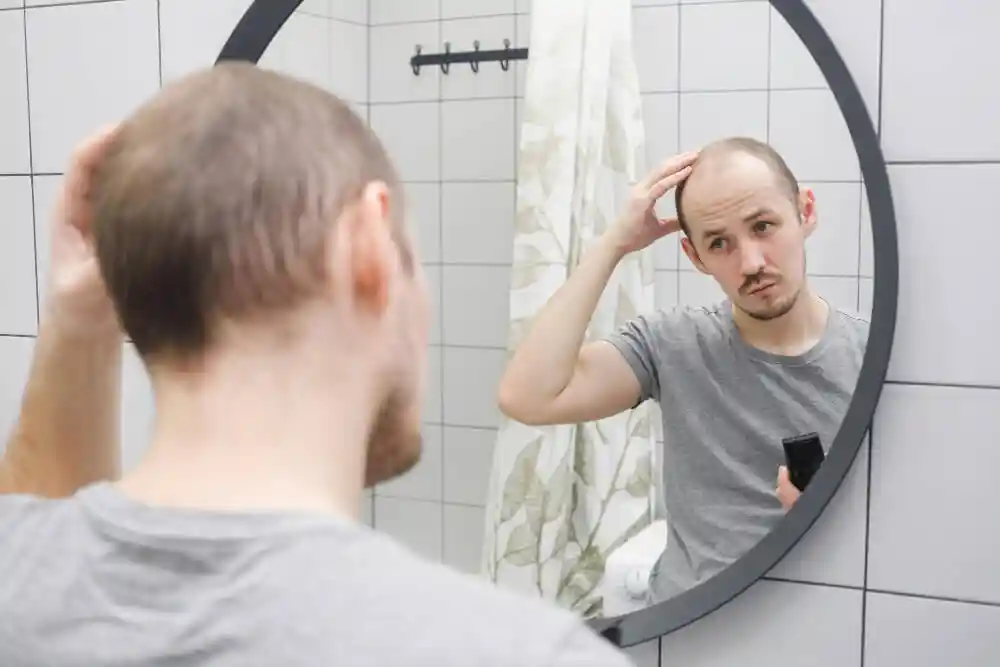
Last updated: 04-04-2023
Male pattern hair loss (MPHL) affects millions of men worldwide. It can have a strong emotional impact. It’s a hereditary genetic condition. MPHL causes some scalp hair to thin over time. This usually follows a pattern. But these days there are ways to slow down, or even reverse, this process. In this blog post, we'll look at:
-
The causes of MPHL
-
How it works
-
Why it affects some people more than others
-
What options there are for treating it
This should help you make an informed decision about your own future hair health.
What is male pattern hair loss (MPHL)?
MPHL is a common worry among men. It usually takes the form of a receding hairline or thinning crown. Often it’s often seen as an inevitable sign of ageing. MPHL can really dent a person’s self-confidence.
Understanding MPHL helps us decide how to treat and prevent it. Luckily, many studies are now looking into the link between hormones and hair. They are finding effective ways to help men keep their hair. Also, how we all talk about MPHL is getting easier and kinder. This helps men find support as they deal with hair loss.
What causes MPHL, and what are the common symptoms?
Male pattern hair loss is mainly caused by a mixture of genes and hormones. As levels of a male hormone (DHT) grow, hair follicles shrink. This leads to thinning hair and then hair loss. Common symptoms include a receding hairline. This often begins at the temples and slowly moves back. Also, thinning hair at the crown may spread. This can lead to partial or complete baldness.
How is MPHL diagnosed, and what treatments exist?
MPHL can make many people worry. But these days it’s much easier to spot it and cope with it. Doctors check your hair and your history to confirm MPHL. They sometimes use further tests to make sure. There’s a growing range of ways to deal with it. They include medicines you apply straight on, such as minoxidil. There are also oral medicines, such as finasteride. These slow down hair loss and stimulate regrowth.
New methods include low-level light therapy (LLLT). This uses lasers to boost hair growth. More invasive methods are also used, such as hair transplants. They allow patients to regain a fuller head of hair.
The pros and cons of treating MPHL with medicine
Medicines such as Propecia (finasteride) can reduce hair loss and promote regrowth. But you must stick with them. Stopping may undo the good work. But potential side effects include sexual dysfunction or an allergic reaction. These put some people off. Also, it’s expensive to use these medicines for a long time.
Other ways to treat MPHL
There are a range of options here. New treatments include various types of laser therapies. They can be used at home. Also, plasma injections are becoming popular.
How to prevent further hair loss
There are various ways to prevent further hair loss and protect your hair:
-
A healthy diet really helps. Key nutrients promote hair growth and strength.
-
Be gentle when combing and styling.
-
Avoid harsh chemicals.
-
Avoid smoking and drugs.
-
Manage your stress levels. Regular exercise can help here.
-
Talk to a dermatologist if your hair loss persists.
Conclusion
Male Pattern Hair Loss is a common issue facing many men. It can be distressing. It helps to understand the causes, symptoms and treatments available. Each person’s case differs. Talk to your doctor to find the best approach. Take healthy steps to prevent hair loss. With the right diagnosis, learning and care plan, you can fight MPHL and keep a healthy head of hair.